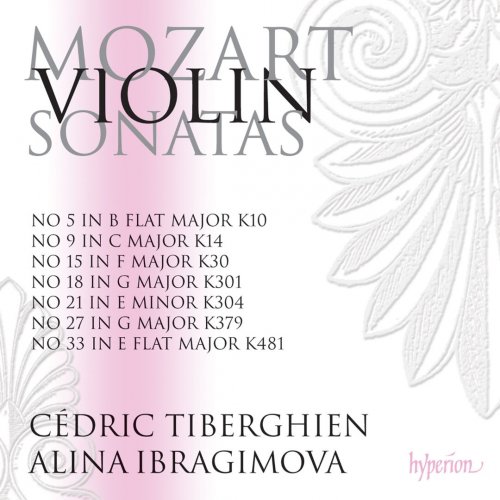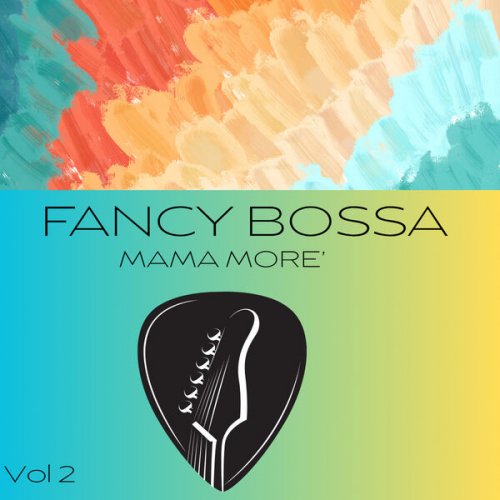Alina Ibragimova, Cedric Tiberghien - Mozart: Violin Sonatas Nos. 5, 9, 15, 18, 21, 27 & 33 (2016) CD-Rip

Artist: Alina Ibragimova, Cedric Tiberghien
Title: Mozart: Violin Sonatas Nos. 5, 9, 15, 18, 21, 27 & 33
Year Of Release: 2016
Label: Hyperion
Genre: Classical
Quality: FLAC (image+.cue,log,scans)
Total Time: 01:43:08
Total Size: 448 Mb
WebSite: Album Preview
Tracklist: Title: Mozart: Violin Sonatas Nos. 5, 9, 15, 18, 21, 27 & 33
Year Of Release: 2016
Label: Hyperion
Genre: Classical
Quality: FLAC (image+.cue,log,scans)
Total Time: 01:43:08
Total Size: 448 Mb
WebSite: Album Preview
CD 1:
Violin Sonata in G major, K301
01. 1: Allegro con spirito (7:39)
02. 2: Allegro (5:33)
Violin Sonata in B flat major, K10
03. 1: Allegro (4:19)
04. 2: Andante (7:03)
05. 3: Menuetto (3:25)
Violin Sonata in E flat major, K481
06. 1: Molto allegro (7:09)
07. 2: Adagio (7:16)
08. 3: Allegretto (with variations) (8:02)
CD 2:
Violin Sonata in G major, K379
09. 1: Adagio – Allegro (9:08)
10. 2: Theme and variations: Andantino cantabile (8:01)
Violin Sonata in F major, K30
11. 1: Adagio (5:50)
12. 2: Rondo: Tempo di Menuetto (3:15)
Violin Sonata in C major, K14
13. 1: Allegro (4:40)
14. 2: Allegro (2:50)
15. 3: Menuetto (3:27)
Violin Sonata in E minor, K304
16. 1: Allegro (9:37)
17. 2: Tempo di Menuetto (5:47)
Performers:
Alina Ibragimova, violin
Cédric Tiberghien, piano
Mozart's violin sonatas come mostly from the first part of his career and probably wouldn't have been counted by the composer among his most significant works. They're transitional between the configuration of piano with optional violin accompaniment and that with the violinist in the lead; pianist Cédric Tiberghien here properly receives top billing, and he catches the right balance with violinist Alina Ibragimova. There is nevertheless a profusion of recordings of these works, which stand at the beginning of the violin sonata tradition that has come down to the present day. This recording stands out from the crowd in a way it wouldn't have a decade before the double album's 2016 release: there is no concession to the ideas of the historical performance movement. Ibragimova cultivates a big, lyrical, perhaps characteristically Russian sound in the spacious Violin Sonata in G minor, K. 379. But the real attraction here is the presence of a trio of early sonatas, all written before Mozart's tenth birthday. These aren't usually included in Mozart violin sonata recordings, and they're a bit more musically accomplished than the early symphonies often presented as displays of Mozart's precocity. They don't exactly lead to the later sonatas; the pianist has the lead role, and they are rather diffuse in structure. But sample the active keyboard part in the Adagio opening movement of the Violin Sonata in F major, K. 30, composed in 1766 (CD 2, track 3); it gives an idea of the impact the child Mozart must have had as a traveling virtuoso. Tiberghien and Ibragimova scale their sound down effectively for these early works, and Hyperion's engineering work at the Wyastone Estate concert hall catches all the details. Recommended for those intrigued by Mozart's childhood.
![Koldo Munné & 1520's Ensemble - Live at Jamboree Live Music (2025) [Hi-Res] Koldo Munné & 1520's Ensemble - Live at Jamboree Live Music (2025) [Hi-Res]](https://www.dibpic.com/uploads/posts/2025-12/1765846749_ck2b0xbsb8jna_600.jpg)

![Stille Grender, Eva Bjerga Haugen - Svart senker natten seg (2025) [Hi-Res] Stille Grender, Eva Bjerga Haugen - Svart senker natten seg (2025) [Hi-Res]](https://www.dibpic.com/uploads/posts/2025-12/1765550212_ktbxqyoaitggb_600.jpg)


![Tomasz Stańko, Tomasz Szukalski, Dave Holland & Edward Vesala - Balladyna (1976/2025) [Hi-Res] Tomasz Stańko, Tomasz Szukalski, Dave Holland & Edward Vesala - Balladyna (1976/2025) [Hi-Res]](https://www.dibpic.com/uploads/posts/2025-12/1765717548_cover.jpg)


